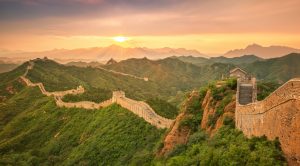Given the recent election, border walls are currently all the rage (or all the worry depending on where you stand). I thought it would be interesting to look back at the history of some famous walls and see why they were built and if they were successful.
Perhaps the most famous wall in the world is the Great Wall of China. It is commonly on lists of the Seven Wonders of the World and can be seen from Earth’s orbit. It was built over thousands of years in sections. In 221 BC the Chinese Emperor Shi Huangdi began the first national wall project in an attempt to join walls that had been built in localities around China to protect farmers and villagers from looting. The emperor’s goal was to link the Chinese as a people (to keep non-Chinese out and Chinese in), as well as, to unify the new country under him. This unity would come from the protection the wall would bring and from the process of building the wall, which would bring people together in their work. It was finished in 214 BC and was considered a great success. The wall was repaired and expanded during the Ming dynasty (1368-1644 AD) and was considered vital to its defense. After the Ming period the wall was no longer considered vital to defense because China expanded northward beyond the wall. Eventually it became a tourist attraction with the most popular portion being near Beijing. The main wall running, east to west, measures about 5,500 miles while the entire wall with all its branches is estimated at over 13,000 miles.
Hadrian’s Wall was built around 122 AD by the Roman Emperor Hadrian. It was constructed to run east to west across Britannia from the North Sea to the Irish Sea. It marked the northern boundary of the Roman Empire and was 73 miles long. It is unclear exactly what its prime purpose was. Perhaps it was built to protect the colony in the south from the northern tribes. Or possibly to control flows of people and therefore taxation. Or finally to be a visible manifestation of the power of the Roman Empire. Maybe it was a combination of all three. It was abandoned by the next emperor who tried to push north but failed to bring the northern tribes under his rule. It was reoccupied then by the Roman Empire until the empire itself began to crumble and was left in the 4th century AD when military assistance was needed closer to home.
Construction of the walls of Constantinople started in 324 AD when Constantine made it the capital of the Roman Empire. A second layer of wall called the Theodosian Wall was added in 410 AD as the city of Byzantium, now known as Constantinople, grew. The walls of Constantinople were predated by two sets of walls built before and just after the time of Christ which were destroyed when the wealthy city changed hands. The walls of Constantinople (and the second layer, the Theodosian Wall, which turned into several layers) protected the great city of Constantinople for hundreds of years from siege and even a massive earthquake. Constantinople was finally taken when the Turks acquired cannons and after the city’s population was lowered as a result of the Crusades. Constantinople fell in 1453. Today the city of Constantinople has been renamed Istanbul and is the capitol of Turkey. Remnants of the inner and outer walls that protected the city for hundreds of years can still be seen.
In the 20th century the Berlin Wall was used by the Soviet Union to keep people from escaping communist rule. It was built in 1961 across and around the city of West Berlin to separate East Germany from West Germany. It was called the “Anti-Fascist Bulwark” by the communists. Before its construction over 3 million people had escaped from east to west. The wall consisted of over 85 miles of concrete topped with pipe and wire fencing. A second fence was built behind the first fence and all buildings and houses in between the two were destroyed to make a “death strip” where there was no cover and wall guards would have a clear shot at anyone trying to escape. Over the 28 years it was up, only 5000 people escaped and at least 200 were killed in the attempt. It was effective at stemming the original tide of millions of defectors. The wall was torn down in 1989 when the USSR fell.
The construction of the Israeli Wall or separation barrier started in 2000. It runs along the Green Line which is the 1949 armistice line between Jordan and Israel. It was set up to stop terrorist attacks from the west bank and is considered a success by that measure. In some places, particularly urban areas where snipers have been an issue, it is a 30 foot concrete wall. However, in less populated areas it takes the form of fencing, barbed wire, ditches and motion detectors. About 250 miles of the wall have been completed with plans for another 130 miles.

